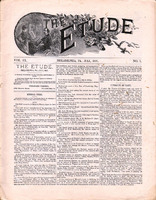We have recently received from the author, Edmund J. Myer, f. s. Sc. (London), a work on the voice entitled "Vocal Reinforcement.'' This is a book for vocal teachers and pupils. It is very cleverly written and takes up the subject of vocal culture theoretically, mechanically, intellectually and practically. Mr. Myer is one of our most successful teachers in voice culture, and this book is the final result of long experience and untiring investigation and experiment. Teachers of vocal music will find much to interest and instruct in this work. Many half-truths are brought to a fall light. It is a book that will well repay careful perusal on the part of all young teachers and thorough study on the part of the pupils. It can be ordered through our office. Price, $2.50.
We have another new work upon this subject called "The Voice in Speech and Song," by Theodore E. Schmauk; Jno. B. Alden, New York, Publisher, 393 Pearl St. Price 75 cents, postpaid.
This is a well-written work and is meeting large sale. Many quotations from standard authorities are introduced into the work, which treats of the voice both from a theoretical and practical standpoint. It is especially adapted to the needs of advanced students and young teachers, while teachers of large experience will find much of interest and value in its pages.
ELEMENTARY HARMONY. By Ludwig Bussler.
New York, G. Schirmer.
The introduction to this work contains an admirably clear statement of the nature and scope of the science of Harmony; of the aims of its study and of the limitations of its relations to free artistic creation.
The treatment of the Consonant Principal Chords begins the work proper, consideration of intervals being omitted. The parallel minor key is presented simultaneously with the major, and the chief chords of each are presented clearly and practically. Then follow practical exercises in the use of these three triads, both in major and minor; but soprano melodies are given instead of basses,—a marked departure from the common practice of the text-books. One might, perhaps, take exception to the early freedom allowed the learner in transferring the common tone from one voice-part to another (p. 12); since the common tone forms one of the most important means of chord-connection, and chord-connection, in natural relations, is the very thing to be taught. If there be anything substantial gained by these breaks, it is not obvious, even to the experimental critic and teacher. It certainly must tend to weaken in the pupil the sense of the importance of strict voice-leading. If this point were strictly insisted on as soon as the open position of chords has been introduced (p. 18), perhaps there would be, after all, little harm done. But, even after that, some of the model exercises (see Model 4, p. 20) break connections unnecessarily. An example occurs, measures 1 and 2, Model 4, where a good connection between Tonic and Dominant could easily have been secured by taking the last chord in meas. 1 in close position. There are examples in succeeding "models" where the voice-leading might be much improved.
The inversions and the rules for their use are well explained. So is the Dominant Seventh and its treatment. The so-called "chord of the Ninth" with its inversions receives elaborate treatment. It would perhaps be wiser to omit all this and treat the ninth, major or minor, as a free suspension or appoggiatura. This would save pupils no small amount of useless labor. Apart from this, the treatment of discords and of free voice-leading is sound and clear, and goes into minute detail. Part I constitutes a solid compendium of the traditional doctrine of harmony, with copious examples. Part II is a thorough, complete and lucid treatment of tones foreign to the harmony; including passing-tones, bye-tones (improperly and meaninglessly called "changing-tones"), strict and free suspensions, anticipations, etc. Part III deals exhaustively, but always from the traditional standpoint, with the subject of modulation. The treatment is clear. But no account is taken of the modern extension of the limits of tonality, as exemplified in Wagner, Liszt and their successors; and no point is made of the important third and sixth relationships which constitute so important an element of modern harmony. This information the student of this book will be obliged to acquire elsewhere, or miss it entirely. Part IV treats of the "altered" chords, clearly and fully.
From its chosen standpoint the book is full and clear, and, with the exceptions above noted, is to be commended. But its standpoint is precisely what it would be if Lohengrin, Tannhäuser and their successors had never been written; and if such men as Hauptmann, von Oettingen and Riemann had never led harmonic speculation into new and promising paths. That no textbook on harmony can be complete, now-a-days, which leaves such matters out of account, need hardly be said. Unless harmonists are hopelessly given over to mental inertia, the harmony teaching of the future must go beyond Mr. Bussler's outlook. J. C. F.



